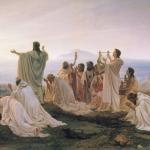You may have heard that Ken Bailey’s new Reading Paul through Mediterranean Eyes (IVP, 2011) won Christianity Today’s “best book” award in the category of “Biblical Studies” – huge praise indeed for someone who is not, first and foremost, a Bible scholar!

I am reviewing this book for Interpretation and they have given me 1400 words to discuss this 550 page tome on 1 Corinthians! This has proven challenging! There is much to say!
Without repeating all the comments in my review, I will offer some basic thoughts here.
First, even though Bailey avoids calling his book a commentary (subtitle: “Cultural Studies in 1 Corinthians”), he works through 1 Corinthians in a passage-by-passage manner, just like a commentary. What is unique, though, is that Bailey draws from his experience over several decades living and working in the Middle East. Also, he puts forward a rather controversial two-pronged claim.
(1) Paul’s first letter to the Corinthians is not an ad-hoc series of responses to questions the Corinthians asked or problems he heard about. It is a carefully constructed whole, written for the benefit of all Christians, but using the Corinthians’ problems as a set of case studies in holiness and obedience to Christ.
(2) Paul’s style in 1 Corinthians owes a major debt to the rhetorical style of the Hebrew prophets. Prophets like Isaiah (especially) wrote using a series of “ring compositions” (what many of us know otherwise as chiasms) and other types of parallel styles. Paul’s letter, according to Bailey, is also set up stylistically like the poetic rhythm of the prophets, where Paul employs similar kinds of parallels – mostly “ring composition,” but other kinds as well. Bailey works through the parallel format of each passage before engaging in commentary.
EVALUATION
When it comes to #1, I found his argument overall helpful and very possible. Emphasizing the Jewishness of, not only the content of 1 Corinthians, but also the structure is something Ciampa and Rosner emphasize as well. I have a harder time with #2. To me, call me a skeptic, but chiasms are in the eye of the beholder and they are very, very difficult to establish in such a way that encourages consensus. Besides, Bailey has to mention Paul’s modifications to chiasms whenever his paradigm doesn’t match up perfectly. It is not so much that Bailey is wrong, but that it is extremely challenging to prove that he is right. And, the proof of the pudding is in the eating, and I simply do not see how his structural and stylistic discussions drive his comments on any given passage – except to point out the central idea, which I think can be done in other ways most of the time.
Witherington, in his recent commentary on Philippians (Eerdmans, 2011), points out a key problem with finding chiasms in a document: “they require one to ‘see’ the structure of the document. But the vast majority of the audience would never see such a thing, as they could not read” (p. 13). Witherington is talking about whole-document chiastic structures, but I think his point works for smaller chiasms – for listeners to identify chiasm as it is being read would seem to me to be extremely challenging. Bailey suggests that Hebrews were trained to identify chiasms as a normal part of poetic communication. But how does that work for the Corinthians, esp those who were Gentile?
Have I become as cynical as Jimmy Dunn?: he writes, “one might simply observe that there seems to be an inverse ratio between the length of proposed chiasms in an individual letter and the light they shed on either the argument or the point. The vigour of Paul’s theology evidently did not allow it to be easily contained within regular grammatical and compositional structures!” (Theology of Paul, 12).
I should say, though, that even if one discounts Bailey’s structure scheme, the commentary is very much still worthwhile. He has translated almost 2 dozen Arabic, Syriac, and Hebrew translations of 1 Corinthians that come from many different periods of the churches’ life and he brings their insight to bear on the interpretation of the text.
Also, he does offer cultural insights, esp from his experience, but I would say that his comments on the text are not that much different than those of Fee or Garland or whoever. What Bailey does bring to the table is his ability to summarize and paraphrase the text and communicate its message clearly and in fresh ways. He is a master writer, and his analogies are very insightful. He also makes some comparisons with religious life in Islam, which is unique in a Pauline commentary as far as my experience goes!
So, is it a worthwhile purchase for students and pastors interested in 1 Corinthians? I would say “yes” for the many small insights, but just know that if you are as skeptical about chiasms as I am, you will end up disagreeing with Bailey’s structure approach. However, if you want to see what it looks like to exposit and engage with the text energetically and passionately, you will find it very good reading.











